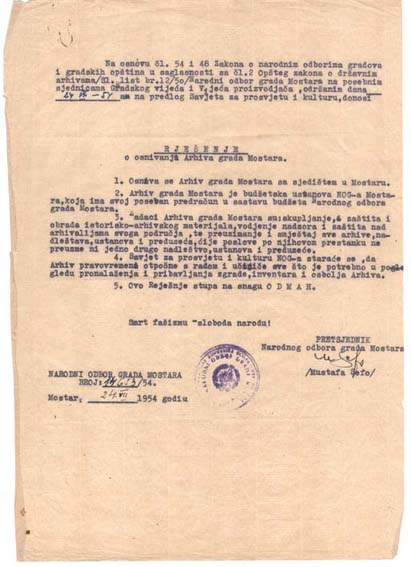History of the Archive
The Archive of the Herzegovina-Neretva Canton/County was created by the Decision of the Government of HNK/Ž dated July 30, 2004, by merging the Archives of Herzegovina Mostar and the Archives of the Croatian Republic of Herceg-Bosna.
With the establishment of the Archives of Herzegovina in Mostar in 1954, the organized activity of collecting, preserving, protecting and processing archival materials in Herzegovina began. The significance, importance and role of the Archives in Mostar and the region is indicated by the amount of archival materials and the organization of archival funds, successful protection outside the Archives, the use of archival values for scientific and evidential purposes, cultural-educational and exhibition activity, and enviable publishing activity.
The archive was founded on July 4, 1954, by decision of the People’s Board of the city of Mostar, no. 14653/54 under the name “Archive of the city of Mostar”.
Regardless of the “city” registration, from the beginning its activity on collecting, organizing, processing and protecting archival material covers the whole of Herzegovina, so by the Decision of the Assembly of the Mostar Region from 06.04. In 1964, the name of the Archives was harmonized with the operational region and received the logical name “Archive Herzegovina Mostar”.
The Archive rightly retains its name, because what it owns, what is deposited in its repositories, represents a treasure trove of information about all of Herzegovina.
A small number of workers, enthusiasts and pioneers of the archival service in Herzegovina, from its establishment until 1960, focused most of their work energy and program tasks on finding and collecting fragmentary documentation of the past. They recorded and protected the materials of numerous companies and institutions, and they took over and transferred unprotected archival materials from attics, basements, warehouses of former merchants and other non-conditional and inappropriate accommodations to the cramped spaces of the Archives.
Visiting numerous families from Mostar and Herzegovina, they found, collected, and partly bought very important historical materials about Mostar and Herzegovina.
These were the first steps in the organized and institutionalized development of archival activities in Herzegovina. Through dedicated work, even though the number of employees ranged from 4 to 8 people, the Archives of Herzegovina already in the 1960s had rich funds of archival materials, manuscripts, photos and unique library items.
Through well thought-out collection and research actions, the employees of the Archives of Herzegovina have collected extensive and content-rich archival material of diverse provenance and character, various contents and forms of recording.
This is evidenced by the fact that the Archive has 320 holdings and 38 collections, as well as a rich photo library, a newspaper library and thousands of xerox copies and transcriptions of primary source documents important for the study of the history of Mostar and Herzegovina, as well as a rich and comprehensive professional library.
The material and personnel base was strengthened, and in the seventies, the necessary conditions for intensive professional work were created, and as a result, numerous scientific information aids (inventories, catalogs, registers, etc.) were created.
The Archive also begins its journalistic activity, and in order to bring the values it preserves to the wider cultural and scientific public, in 1973 it publishes its first book, “A Guide to the Funds and Collections of the Archives of Herzegovina”.
A little later, he published the “Catalog of Arabic, Turkish and Persian Manuscripts of the Archives of Herzegovina”, and in 1981 he started the magazine (yearbook) for cultural and historical heritage “Herzegovina”, whose 10 issues delighted lovers of cultural and historical tradition, thirsty for new knowledge.
Lectures, seminars, exhibitions become practice and a companion to the activity and presence of the Archive in the cultural and social life of Mostar and Herzegovina.
Those who follow the development path of this important institution will remember that the employees of the Archives, bearing the burden of responsible work, presented to the public the exhibitions: “Letters in the documents and manuscripts of the Archives”, “Mostar from the Turkish period in the documents of the Archives”, “Through the funds and collections of the Archives”. “Oriental collection of the Archives”, “120 years of the Mostar Tobacco Factory”, “Mujaga Komadina 1839-1925”, “Sources of information and evidence”, “Anti-fascist struggle of Herzegovina (1941-1945)” and others.
The archive was constantly enriched with new contents and library values, with its activities and achieved results it earned the epithet of an exemplary archival institution in Bosnia and Herzegovina. Then, from 1992, enormous cultural values, among them important archival material, disappeared in a destructive and destructive attack. The suffering of the Archives of Herzegovina (depots and registries) has never been precisely done. The enthusiasm of the employees, the understanding of the city authorities and the financial resources of the EU in Mostar have created the conditions for a new takeoff, because the existing archival wealth needs to be supplemented, much better preserved and jealously protected for current and future generations. Even in the most difficult working and wartime circumstances, valuable and useful work, the preservation and protection of the rich cultural heritage, dedicated workers managed to collect and enrich with new contents the existing funds and collections, the library, the camera library, the photo library, but also acquired the appropriate technical and process equipment and thus created optimal conditions for more efficient and functional work.
Decision on establishment

